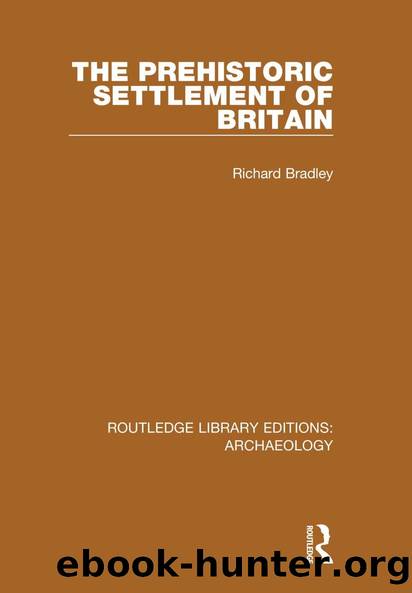The Prehistoric Settlement of Britain by Richard Bradley

Author:Richard Bradley [Bradley, Richard]
Language: eng
Format: epub
Tags: Social Science, Archaeology
ISBN: 9781317612865
Google: 9hYcBQAAQBAJ
Publisher: Routledge
Published: 2014-10-24T05:58:15+00:00
One curious aspect of this predominance of red deer is its occurrence in areas outside its natural habitat and beyond at least its modern distribution. Some of these sites were on small islands, on which it could hardly have been supported. One example is the Orcadian island of North Ronaldsay; Arthur MacGregor, in discussing the bones from Burrian broch, suggested that venison was brought here from elsewhere (1974, p. 105). The special importance of this animal on South Uist is emphasised by a curious find from an Iron Age house at Drimore (Fairhurst, 1971, p. 80). Here the centre of the hut floor contained a circle of about twenty unburnt jaw bones. Another example comes from Dun Mor Vaul (McKie, 1974). Here the initial problem is that pollen analysis has shown a completely open landscape, which would not be very suitable for roe deer, despite its representation among the bones. This contrasts with the poor representation of pig. In her report Noddle argued that the phases in which young domestic animals were killed would reflect the periods in which resources came under most pressure. It is particularly interesting that the main evidence for hunting is not in these periods of strain. For this reason it would appear that hunting was more than a supplement to the basic diet. It was actually practised most while the site functioned as a broch. The faunal analysis for this site has been misused and Table 7 offers the basic evidence. This represents the minimum number of animals in each phase and not the gross number of bones. Bird bones are considered separately.
McKie has claimed that a high proportion of game bones is characteristic of sites in this region (1977, pp. 219 ff.) and if brochs were socially eminent forms, this could offer at least some explanation. On the shoreline, as in inland areas, hunting may have changed from an economic to a social practice.
Although there is every reason to expect that hunting would be complemented by the use of other resources, this is not easy to prove, even for the Mesolithic period. In later prehistory, when hunting was a minor supplement to farming, the evidence for other practices remains extremely slight. Plant foods will normally survive only in waterlogged or carbonised deposits and specialised techniques may be needed to recover them. Fishbones are brittle and usually poorly preserved, and the same applies to bird bones. In each case the sample from conventional excavation will be both small and distorted. The opposite applies to shellfish, which are very well represented, although their numbers belie their low nutritional status. The following account is necessarily based on data of poor quality and until more sophisticated analysis becomes available, discussion can only be conducted in the most general terms.
TABLE 7: Distribution of animal bones at Dun Mor Vaul
Download
This site does not store any files on its server. We only index and link to content provided by other sites. Please contact the content providers to delete copyright contents if any and email us, we'll remove relevant links or contents immediately.
The European History Highway: A Guide to Internet Resources by Dennis A. Trinkle Scott A. Merriman(494)
The Seven Wonders of the Ancient World by Michael Denis Higgins(478)
European Security in a Global Context by Thierry Tardy(470)
European Security without the Soviet Union by Stuart Croft Phil Williams(469)
The Routledge companion to Christian ethics by D. Stephen Long Rebekah L. Miles(458)
Hudud Al-'Alam 'The Regions of the World' - a Persian Geography 372 A.H. (982 AD) by V. V. Minorsky & C. E. Bosworth(399)
Gorbachev And His Generals by William C. Green(391)
Get Real with Storytime by Julie Dietzel-Glair & Marianne Crandall Follis(390)
Tibetan Studies in Comparative Perspective by Chih-yu Shih Yu-Wen Chen(385)
Governance, Growth and Global Leadership by Espen Moe(381)
Hyperculture by Byung-Chul Han(378)
CliffsNotes on Fitzgerald's The Great Gatsby by Kate Maurer(360)
The Oxford History of the World by Fernández-Armesto Felipe;(354)
How Languages Are Learned 5th Edition by Patsy M Lightbown;Nina Spada; & Nina Spada(353)
The Egyptian Economy, 1952-2000 by Khalid Ikram(352)
Oral Poetry and Narratives from Central Arabia: The Poetry of Ad-Dindan : A Bedouin Bard in Southern Najd (Studies in Arabic Literature, Vol 17) (English and Arabic Edition) by P. M. Kupershoek P. Marcel Kurpershoek(345)
The Oxford Handbook of the Incas by Sonia Alconini(333)
Europe Contested by Harold James(319)
The Hutchinson Dictionary of Ancient and Medieval Warfare by Peter Connolly John Gillingham John Lazenby(305)
